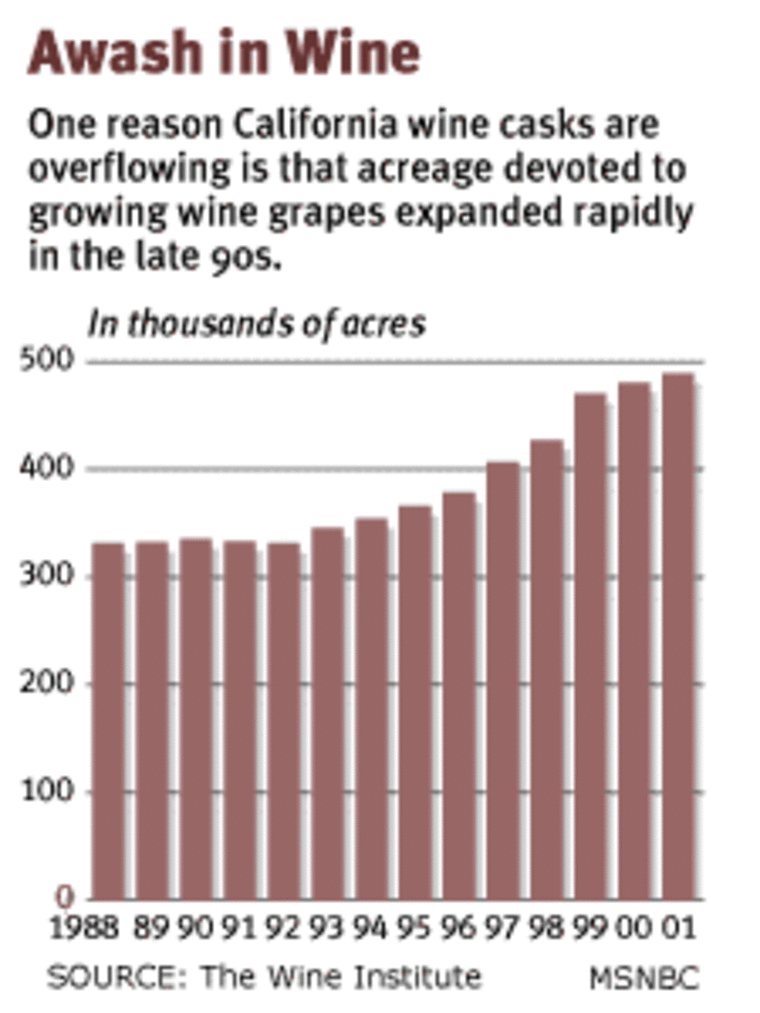For California grape growers, a string of bumper crops has brought plunging prices, forcing some growers to leave their crop withering on the vine. That’s been great news for wine drinkers, who have been harvesting big bargains as a result of the grape glut. But if you’re a wine lover, you’d better stock up: There are already signs that the party may be ending.

THE SEEDS OF THE current oversupply of wine grapes were sown in the late 1990s, when a bumper crop in 1997, together with a booming economy, prompted growers to plant more vines. Both long-time vintners and newbies flush with dot-com riches expanded the state’s wine grape acreage by 34 percent in just six years.
But it takes three to four years for those vines to produce viable fruit. The resulting bumper crop flooded the wine market just as the economy turned sour.
“The decision to plant the vines can be made in a flush moment, said Mary-Ewing Mulligan, co-author of Wine for Dummies. “A lot of the vines that are overproducing now were planted in the late 1990s when times were good. But then you can’t capitalize on that decision for a couple of years.”
Now, with an abundance of grapes bringing a steep drop in prices, capitalizing on the crop is proving especially tough. In 2002, some 3.8 million tons of California grapes were crushed for wine — up 12 percent from 2001. But prices sank 17 percent, to $462 a ton. For some growers, the steep price drop wiped out profits, turning a bumper crop into a personal bust.
“We’re seeing a lot of people pulling out vines now,” said David Beckstoffer, whose Napa Valley vineyard sells most of its crop under long-term contracts. “People that are in a situation where they sell year-to-year can’t sell at any price. There’s just no market for grapes right now.”

That oversupply of grapes has brought an oversupply of wine — particularly the 2000 vintage, much of which remains unsold. Despite that abundance, wines made in 2000 weren’t a hit with wine reviewers. So, with casks overflowing, wineries have been forced to cut prices or spend more money promoting their brands.
TWO BUCK CHUCK
For wine drinkers, the grape glut has produced a flood of cheap wine, including a new category of super-cheap varietals pioneered by Bronco Wine Company, and sold under the Charles Shaw label for $1.99 a bottle. “Two-Buck Chuck,” sold in Trader Joe’s supermarkets, soon became a hit with California wine drinkers.
“People have been coming back buying 8, ten cases at a time,” Harvey Posert, a spokesman for Bronco Wines told CNBC. “The amount of wine you can fit in your trunk.”
The good news, say wine makers, is that this new category of presentable, super-cheap wine is expanding their market by appealing to budget-conscious consumers who don’t think of themselves as wine drinkers.
“The bad news is that people are really trading down from wines costing $10 to Two-Buck Chuck,” said Jon Fredrikson, president of wine industry consultants Gomberg, Fredrikson & Associates. “For $8 a bottle, it’s not worth the difference.”
But this bargain bacchanal for wine drinkers won’t last forever. Already, supply and demand for some varieties — including chardonnay and merlot — are beginning to come back into balance, says Frederickson.
And after battling imported wines from Europe, South America and Australia, California wine makers are getting a hand from some of their best customers — international currency traders.
“The strength of the dollar had made things highly competitive,” said Gladys Horiuchi, a spokeswoman for the Wine Institute, a California trade group. “That situation has changed since last fall.”
A weaker dollar means foreign wine makers have to raise their prices — in dollars — in order to make the same profit in their local currency. That makes it easier for domestic producers to raise prices, too — or at least eases pressure to cut them. The flip side is that American wine looks like a bargain to European wine drinkers, helping to boost U.S. exports.
“If California exports move up, that begins to dry up the surplus,” said Fredrikson. “The timing (of the dollar’s slide) is great” for the U.S. wine industry, he added.